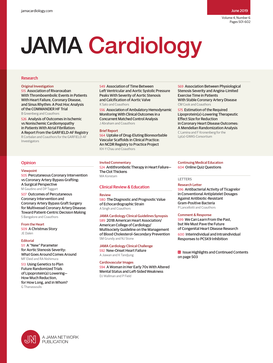Prognostic Value of Papillary Muscle Scarring in Patients With Dilated Cardiomyopathy.
IF 14.1
1区 医学
Q1 CARDIAC & CARDIOVASCULAR SYSTEMS
引用次数: 0
Abstract
Importance Papillary muscle scarring (papSCAR) can occur without epicardial coronary artery disease, likely due to microvascular dysfunction. Dilated cardiomyopathy (DCM) has been associated with microvascular dysfunction; the prevalence and prognostic significance of papSCAR in patients with DCM are unclear. Objective To determine the prevalence of papSCAR in patients with DCM and to evaluate if papSCAR is associated with adverse outcomes. Design, Setting, and Participants This cohort study was conducted among consecutive patients with known or suspected DCM prospectively enrolled at an academic hospital in North Carolina from January 2011 to December 2020. Patients were referred for cardiovascular magnetic resonance (CMR) imaging, and the study protocol included flow-independent dark blood delayed-enhancement (FIDDLE) imaging, which improves the detection of papSCAR. Data were analyzed from January 2022 to December 2022. Main Outcomes and Measures The primary end point was cardiac mortality. Secondary end points included a composite of heart failure events (heart failure death or cardiac transplant) and a composite of arrhythmia events (sudden cardiac death [SCD] or aborted SCD). Results This cohort study included 470 patients (mean [SD] age, 55.3 [14.3] years; 205 female patients [43.6%]). During up to 8 years of follow-up (2082 patient-years), there were 53 cardiac deaths, 49 heart failure events, and 24 arrhythmia events. PapSCAR was present in 137 patients (29.1%), and mean (SD) left ventricular ejection fraction (LVEF) was similar between those with and without papSCAR (30.7% [11.0%] vs 31.4% [10.3%]; P = .52). Patients with papSCAR had a higher rate of cardiac death than those without (19.0% vs 8.1%; hazard ratio [HR], 2.30; 95% CI, 1.34-3.95; P = .002). After adjustment for prespecified variables known to have prognostic value in DCM (age, systolic blood pressure, heart rate, LVEF, and midwall myocardial scar), papSCAR was independently associated with cardiac death (HR, 1.86; 95% CI, 1.07-3.24; P = .03) and provided incremental prognostic value (incremental χ2, 4.68; P = .03). PapSCAR was also independently associated with heart failure events (HR, 2.05; 95% CI, 1.16-3.61; P = .01) and arrhythmia events (HR, 3.41; 95% CI, 1.46-7.94; P = .005). Conclusions and Relevance In this single-center cohort study, papSCAR as detected by dark blood delayed-enhancement CMR was present in approximately one-third of patients with DCM and was independently associated with cardiac death.扩张型心肌病患者乳头状肌瘢痕的预后价值。
重要性乳头肌瘢痕(papSCAR)可以在没有心外膜冠状动脉疾病的情况下发生,可能是由于微血管功能障碍。扩张型心肌病(DCM)与微血管功能障碍有关;papSCAR在DCM患者中的患病率和预后意义尚不清楚。目的确定DCM患者papSCAR的患病率,并评估papSCAR是否与不良预后相关。设计、环境和参与者本队列研究于2011年1月至2020年12月在北卡罗来纳州的一家学术医院前瞻性地招募了已知或疑似DCM的连续患者。患者接受心血管磁共振(CMR)成像,研究方案包括血流无关的暗血延迟增强(FIDDLE)成像,这提高了papSCAR的检测。数据分析时间为2022年1月至2022年12月。主要结局和测量:主要终点为心脏死亡率。次要终点包括心力衰竭事件的复合(心力衰竭死亡或心脏移植)和心律失常事件的复合(心源性猝死[SCD]或SCD流产)。结果该队列研究纳入470例患者(平均[SD]年龄55.3[14.3]岁,女性205例[43.6%])。在长达8年的随访期间(2082例患者年),有53例心脏死亡,49例心力衰竭事件和24例心律失常事件。137例(29.1%)患者存在PapSCAR,有和没有PapSCAR的患者平均左室射血分数(LVEF)相似(30.7% [11.0%]vs 31.4% [10.3%]; P = 0.52)。papSCAR患者的心源性死亡率高于非papSCAR患者(19.0% vs 8.1%;风险比[HR], 2.30; 95% CI, 1.34-3.95; P = 0.002)。在调整已知对DCM有预后价值的预先指定变量(年龄、收缩压、心率、LVEF和中壁心肌疤痕)后,papSCAR与心源性死亡独立相关(HR, 1.86; 95% CI, 1.07-3.24; P =。03),并提供增量预后价值(增量χ2, 4.68; P = .03)。PapSCAR也与心力衰竭事件独立相关(HR, 2.05; 95% CI, 1.16-3.61; P =。01)和心律失常事件(HR, 3.41; 95% CI, 1.46-7.94; P = 0.005)。结论和相关性在这项单中心队列研究中,暗血延迟增强CMR检测到的papSCAR存在于大约三分之一的DCM患者中,并且与心源性死亡独立相关。
本文章由计算机程序翻译,如有差异,请以英文原文为准。
求助全文
约1分钟内获得全文
求助全文
来源期刊

JAMA cardiology
Medicine-Cardiology and Cardiovascular Medicine
CiteScore
45.80
自引率
1.70%
发文量
264
期刊介绍:
JAMA Cardiology, an international peer-reviewed journal, serves as the premier publication for clinical investigators, clinicians, and trainees in cardiovascular medicine worldwide. As a member of the JAMA Network, it aligns with a consortium of peer-reviewed general medical and specialty publications.
Published online weekly, every Wednesday, and in 12 print/online issues annually, JAMA Cardiology attracts over 4.3 million annual article views and downloads. Research articles become freely accessible online 12 months post-publication without any author fees. Moreover, the online version is readily accessible to institutions in developing countries through the World Health Organization's HINARI program.
Positioned at the intersection of clinical investigation, actionable clinical science, and clinical practice, JAMA Cardiology prioritizes traditional and evolving cardiovascular medicine, alongside evidence-based health policy. It places particular emphasis on health equity, especially when grounded in original science, as a top editorial priority.
 求助内容:
求助内容: 应助结果提醒方式:
应助结果提醒方式:


